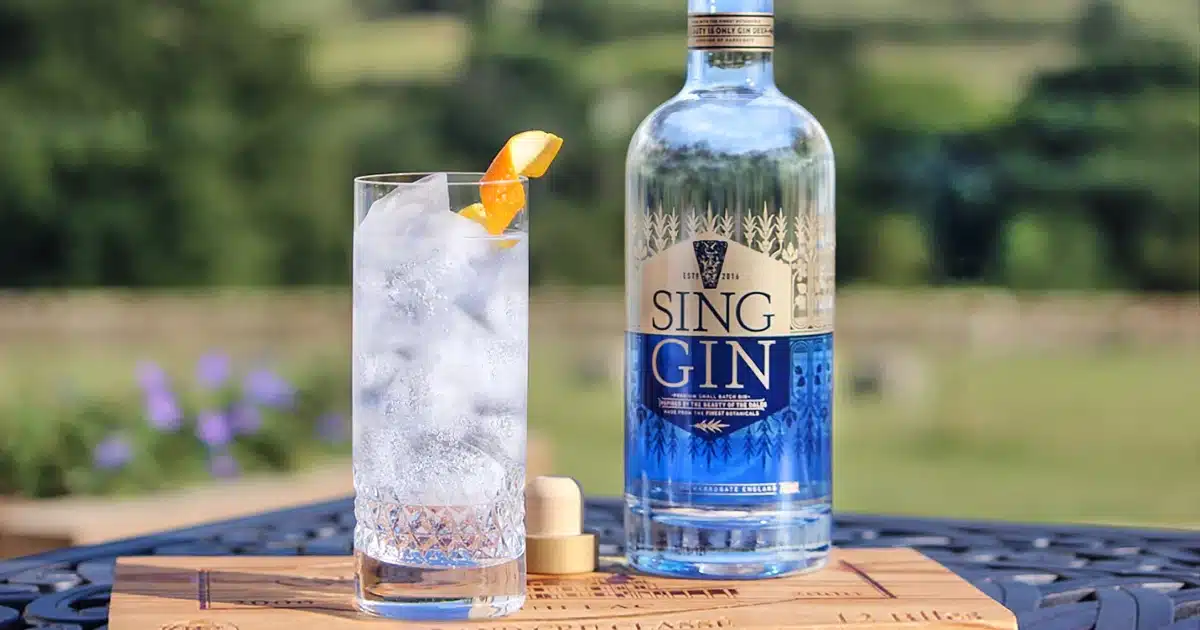VIEW OUR RANGE OF GIN HAMPERS TODAY

Are you looking for the most delicious, refreshing and crisp gin and tonic recipe? We’ve already revealed the botanicals in our small-batch gin so we thought we’d share some more trade secrets and teach you how to mix the perfect gin and tonic!
Before you crack open the Sing Gin, let’s take a look into the history and science behind making a good gin and tonic.
Allow us to take you on a short but insightful journey, starting with a brief history of the gin and tonic, which tonic water tastes best with gin, the perfect gin to tonic ratio and the ideal glass to serve your gin and tonics in.
We’ll leave the drinking part to you!
Who doesn’t love a gin hamper? The perfect gifts for drinkers of gin, our hampers rise to any occasion – from birthdays to anniversaries, congratulations to new homes, Christmas or just to say thank you. Discover our range of luxury gin hampers here.
We all have a blurry past, and the mighty gin and tonic is no exception. The gin and tonic story began in South America with the roots of a tree known as the Cinchona tree.
The quinine extracted from the Cinchona bark is used to flavour tonics, bitters and aromatised wines. Not only does it deliver exceptional flavour, the bark was used as a medicine by Andean tribes to treat fevers, heart problems and malaria. In World War II, soldiers consumed quinine to fight off the threat of malaria.
Not everyone was a fan of the bitter taste and British colonists discovered that adding a splash of gin dramatically improved the taste of the remedy. Hooray, the gin and tonic recipe was born!
Three quarters of the perfect gin and tonic is a sparkling soft drink which contains quinine, citric acid and sugar.
In the 1870s, Schweppes, well-known for their carbonated water, launched their first tonic water. Over a century later, in 2005, Fever-Tree set-up their stall in London with their Premium Indian Tonic Water. Since then, a selection of boutique, artisan tonic brands have arrived on the scene driving innovation and choice. There are now flavoured tonic waters, with varying quinine levels and sugar sources available.
To mix a good gin and tonic, don’t cut any corners. Choose a tonic which is made with real ingredients, no artificial flavours, high fructose corn syrup or saccharin!
Our perfect gin and tonic recipe uses the Fever-Tree Mediterranean Tonic. This tonic is low on quinine and the addition of rosemary and lemon thyme provide a much lighter, more fragrant tonic than the average.
Always measure your gin out first. By getting the gin to tonic ratio right, you will create magic! To create the ultimate serve, pour one-part gin to three parts tonic.
Not a tonic fan? If you’re drinking gin straight, the best glassware to use is a Tasting Glass: a small, tulip-shaped glass which helps to concentrate the aromas of botanicals.
For a truly delicious gin and tonic you can use a Tumbler, Highball or the Gin Tonica glass. On trend particularly in Spain is the Gin Tonica (or Copa), a tall, stemmed glass with a large bowl.
Our favourite glass to use is the Highball, a tall glass typically used for long drinks. The reason we love this glass is because as the ice stacks up vertically, the cubes melt at a slower rate than they do in other glass types.
So… you’ve got your glass and your Sing Gin, what’s the next most important ingredient in a gin and tonic? Ice!
Contrary to popular belief, adding ice will not water down your drink. Ice actually improves the gin and tonic as water releases the hold that alcohol has on aromatic molecules. This amplifies rather than dilutes the flavour.
We’re spoiled for choice with the astonishing variety of garnishes available, but an orange twist or a sprig of mint are sure winners and they work beautifully in our big flavoured gin!
The leafiness of the mint will add a little punch to the orange whilst providing depth. Using an orange twist will add a touch of freshness without spoiling the delicate aromas. If you’re feeling adventurous, try both!
Your perfect gin and tonic all depends on your palate, but this is our favourite gin and tonic recipe:
Ingredients
50ml of Sing Gin
150ml of Fever-Tree Mediterranean Tonic Water
Plenty of fresh ice
A twist of orange and a sprig of mint
Method
Load up a tall glass with the ice, pour the Sing Gin over the rocks and top up with tonic. Give the mint a smack between your hands to bring out the aromas and help the flavour infuse into your drink, garnish and serve.
What are you waiting for? Start serving the best gin and tonics that your family and friends have ever tasted and enjoy the compliments that roll in!
If you’d like to receive more fascinating gin facts and recipe hacks as well as exclusive discounts, subscribe to our email list. You can also follow Sing Gin on Facebook, Instagram, Twitter and Pinterest.